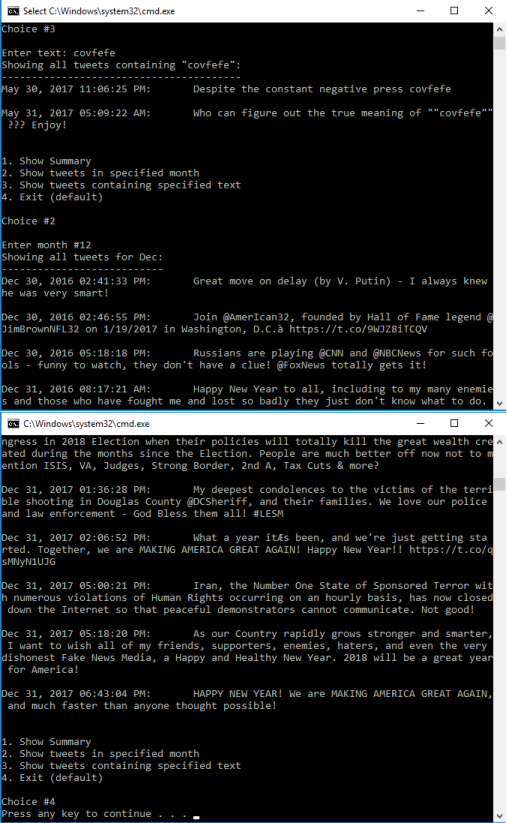KIT107 Programming 2018
Assignment 2
Due Date
The assignment is due at 3PM Wednesday September 19th 2018

Background
Ah, the Donald. Everyone’s favourite President. A modern politician who shares his, um, ‘thoughts’ with us each day via Twitter. You could follow his thoughts too (@realdonaldtrump) but let’s face it, you’ve got better things to do. Like this assignment… So I’ll do it for you.
I’ve archived my favourite 4000ish President Trump tweets into a single text file. That’s all of them from 30/12/’16 up to 14/8/’18. The file consists of one tweet per line; each tweet consists of the date and time, a tab character, and then the text of the tweet.
You will need to store the collection of tweets in monthly clusters (January– December) and within each cluster the tweets should be stored in the order they are added (i.e. first ones at the front, last ones at the back). You will need to provide some summary data (e.g. number of tweets per month, total number of tweets), and an ability to display all tweets containing a certain string, e.g. “fake news” or “dog”, or for a certain month.
a Which underlying data structure (array or linked-list) will you use as a basis to model the collection? In two–three sentences, justify your answer.
b Which kind of abstract data type (binary tree, general tree, array, stack, priority queue, double-ended queue, set, list, etc.) would you use to model the collection? In two–three sentences, justify your answer by indicating the functionality required.
c Which underlying data structure (array or linked-list) will you use as a basis to model the cluster of tweets for each month? In two–three sentences, justify your answer.
d Which kind of abstract data type (binary tree, general tree, array, stack, priority queue, double-ended queue, set, list, etc.) would you use to model the cluster of tweets for each month? In two–three sentences, justify your answer by indicating the functionality required.
The types required to implement this include the following:
typedef ??? cluster; typedef struct {
char *name; cluster tweets;
} month;
typedef ??? collection; collection archive;
In other words, you must create a struct (called month in the above example) which combines the month’s name with your answer to (c) above to represent the cluster of tweets for that particular month, and then use that as a basis for another type (used to create a variable called archive in the above example) which uses your answer to (a) above to create a collection of months. Therefore, you must define both cluster and collection.
A tweet is defined as follows:
struct tweet_int { char date[30]; char text[300];
};
typedef struct tweet_int *tweet;
and you may assume the existence of those types and the following functions:
void init_tweet(tweet *tp, char *t_name, char *t_text); char *get_date(tweet t);
char *get_text(tweet t);
void set_date(tweet t, char *t_name); void set_text(tweet t, char *t_text); char *to_string(tweet t);
A Visual Studio project is available on MyLO for you to download and use as a starting point. This comprises the following files:
· tweet.h and tweet.c — the Tweet ADT as specified above. These files are complete;
· assig_two218.c — the file which contains the main() function and other functions which implement the required task (including reading tweets from the text file).
e You must complete assig_two218.c by adding the month, cluster, and collection types from above, the archive variable (which may be defined globally), and also functions to store tweets read from the file in your
collection and to search and display the results. Function stubs are already present; you must complete these and may add others.
If your answer to (a) or (c) above is a linked-list then you will also need to write
node.h and node.c and add them to the project.
The project also contains the data file. This is just a text file which can be opened with most applications.
Program specification
First you must obtain the from a text file. The data must be stored in appropriate collections. At the top level there should be 12 months and for each there should be a cluster of the tweets (stored in the order encountered).
As a tweet is read from the file, the tweet should be stored in the appropriate collection and cluster (depending upon the month).
Once the data have been read in and stored in the collections, summary information (see below) should be provided and the user should be prompted to enter a search string. All tweets containing that search string — case insensitive — should then be displayed in order or month (but regardless of year) and the number of tweets displayed should should be printed. Hint: the code contains a function, lower(), to convert text to lower-case so that case-insensitive comparison may be made. The comparison can be made using strstr() which looks for its second parameter within its first.
The output of your program should look something like the following:


Program Style
The program you write for this assignment must be contained in five files as follows:
· tweet.h and tweet.c for managing a tweet;
· node.h and node.c for nodes of linked lists (if appropriate);
· assig_two218.c for the main algorithm which controls the reading of the data, the management of the collections, the searching, and the display of the results. There should be at least three functions excluding
the main() function within this file. No function should be longer than about half a screen-full or so of code.
Your program should follow the following coding conventions:
· const variable identifiers should be used as much as possible, should be written all in upper case and should be declared before all other variables;
· #defined symbols should be used for constant values if const is inappropriate
· global variables should be used sparingly with parameter lists used to pass information in and out of functions.
· local variables should only be defined at the beginning of functions and their identifiers should start with a lower case letter;
· every if and if-else statement should have a block of code (i.e. collections of lines surrounded by { and }) for both the if part and the else part (if used)
· every do, for, and while loop should have a block of code (i.e. {}s)
· the keyword continue should not be used;
· the keyword break should only be used as part of a switch statement;
· opening and closing braces of a block should be aligned;
· all code within a block should be aligned and indented 1 tab stop (or 4 spaces) from the braces marking this block;
· commenting:
o There should be a block of header comment which includes at least
§ file name
§ student name
§ student identity number
§ a statement of the purpose of the program
§ date
o Each variable declaration should be commented
o There should be a comment identifying groups of statements that do various parts of the task
o Comments should describe the strategy of the code and should not simply translate the C into English
What and how to submit
What to submit
You must make both a paper and an electronic submission.
Paper submission
· A paper cover page (blanks can be collected from the Information and Communications Technology Discipline Help Desk).
· Written answers to parts (a)–(d) above.
· A landscape oriented print-out of assig_two218.c and any other program files you have added to the solution. Your assignment will not be fully marked unless these are present.
Electronic submission
· You should submit the entire Visual Studio project folder compressed as a ZIP file.
How to submit
Paper submission
· Firmly staple together all of the required documents (with the signed cover page on top) and place them in the appropriate submissions box near the ICT Help Desk.
Electronic submission
· You should ZIP the Visual Studio project folder and then submit it to the “Assignment 2” assignment drop-box on KIT107’s MyLO site.
Marking scheme
|
Task/Topic |
Maximum mark |
|
Design |
|
|
ADTs chosen wisely |
3 |
|
Data structures correct and justified |
3 |
|
Program operates as specified |
|
|
node.c correctly completed (if required, or array equivalent) |
6 |
|
assig_two218.c correctly completed — |
|
|
· initialise_archive() to initialise the archive variable |
2 |
|
· add_existing() to |
|
|
o add a tweet to a non-empty cluster |
2 |
|
o in first-in-first-out order |
2 |
|
· add_tweet() to |
|
|
o add a tweet to an empty cluster |
3 |
|
o call add_existing() to add a tweet to a non-empty cluster |
1 |
|
· show_summary() to display the summary for menu option 1 |
5 |
|
· show_month() to display all relevant tweets for menu option 2 |
4 |
|
· show_selection() to display all relevant tweets for menu option 3 |
5 |
|
Program Style |
|
|
Does not unnecessarily repeat tests or have other redundant/confusing code |
4 |
|
Uses correctly the C naming conventions |
4 |
|
Alignment of code and use of white space makes code readable |
4 |
|
Always uses blocks in branch and loop constructs |
4 |
|
Meaningful identifiers |
4 |
|
Variables defined at the start of functions |
4 |
|
Header comments for the program (author, date etc.) |
4 |
|
Each variable declaration is commented |
4 |
|
Comments within the code indicate the purpose of sections of code (but DO NOT just duplicate what the code says) |
4 |
Plagiarism and Cheating:
Practical assignments are used in the ICT discipline for students to both reinforce and demonstrate their understanding of material which has been presented in class. They
have a role both for assessment and for learning. It is a requirement that work you hand in for assessment is substantially your own.
Working with others
One effective way to grasp principles and concepts is to discuss the issues with your peers and/or friends. You are encouraged to do this. We also encourage you to discuss aspects of practical assignments with others. However, once you have clarified the principles, you must express them in writing or electronically entirely by yourself. In other words you must develop the algorithm to solve the problem and write the program which implements this algorithm alone and with the help of no one else (other than staff). You can discuss the problem with other students, but not how to solve it.
Cheating
· Cheating occurs if you claim work as your own when it is substantially the work of someone else.
· Cheating is an offence under the Ordinance of Student Discipline within the University. Furthermore, the ICT profession has ethical standards in which cheating has no place.
· Cheating involves two or more parties.
o If you allow written work, computer listings, or electronic version of your code to be borrowed or copied by another student you are an equal partner in the act of cheating.
o You should be careful to ensure that your work is not left in a situation where it may be stolen by others.
· Where there is a reasonable cause to believe that a case of cheating has occurred, this will be brought to the attention of the unit lecturer. If the lecturer considers that there is evidence of cheating, then no marks will be given to any of the students involved. The case will be referred to the Head of School for consideration of further action.
Julian Dermoudy, August 20th 2018.
代写CS&Finance|建模|代码|系统|报告|考试
编程类:C代写,JAVA代写 ,数据库代写,WEB代写,Python代写,Matlab代写,GO语言,R代写
金融类:统计,计量,风险投资,金融工程,R语言,Python语言,Matlab,建立模型,数据分析,数据处理
服务类:Lab/Assignment/Project/Course/Qzui/Midterm/Final/Exam/Test帮助代写代考辅导
天才写手,代写CS,代写finance,代写statistics,考试助攻
E-mail:850190831@qq.com 微信:BadGeniuscs 工作时间:无休息工作日-早上8点到凌晨3点
如果您用的手机请先保存二维码到手机里面,识别图中二维码。如果用电脑,直接掏出手机果断扫描。

